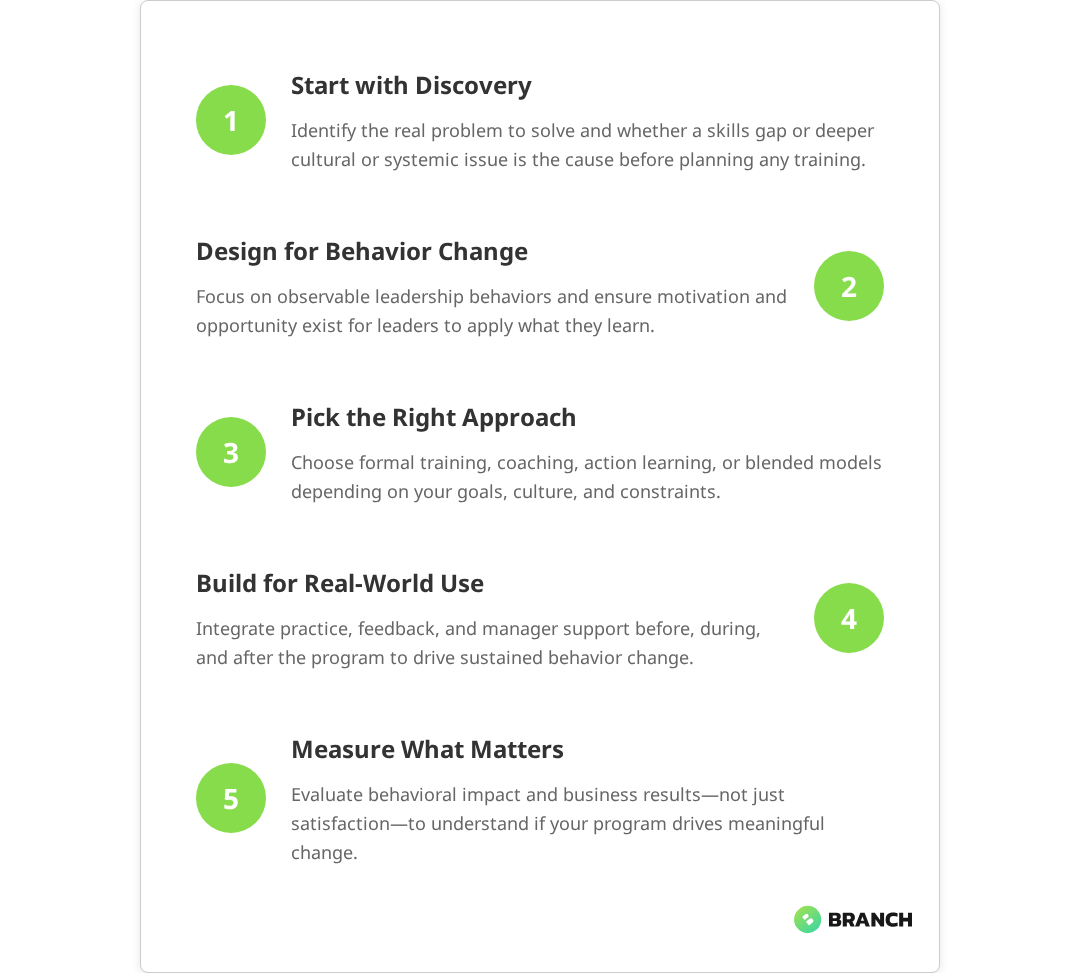Building effective leadership development programs isn’t just about picking the right training modules or finding the most charismatic facilitators. It’s about solving real organizational challenges through targeted, measurable interventions that help your people grow into the leaders your business actually needs.
Yet most leadership programs fail to deliver meaningful results. They consume budget and time while producing vague outcomes that sound impressive in reports but don’t translate to better decision-making, stronger team performance, or improved business results. The difference between programs that work and those that don’t comes down to how well you understand the problem you’re solving—and whether leadership training is even the right solution.
This guide will walk you through building leadership development programs that create real change, from initial discovery through implementation and measurement. Whether you’re an L&D leader, HR director, or executive sponsor, you’ll learn how to avoid common pitfalls and design programs that align with business outcomes.
Start with Discovery, Not Training
The biggest mistake in leadership development? Starting with the assumption that training is the answer. Leadership development experts emphasize that effective programs should begin with discovery, alignment with business priorities, and assessment rather than assuming training alone will solve leadership gaps. Before you design a single module or book a single facilitator, you need to understand what specific business outcome you’re trying to achieve and whether a skills gap is actually the root cause.
Most leadership challenges stem from one of four areas:
- Skills deficits: Leaders lack specific competencies (coaching, strategic thinking, conflict resolution)
- Process barriers: Systems, tools, or workflows prevent good leadership practices
- Cultural issues: Organizational norms, incentives, or accountability structures undermine leadership effectiveness
- Motivation problems: Leaders know what to do but aren’t motivated to do it consistently
Training only solves the first problem. Research confirms that traditional training primarily addresses specific skill gaps but falls short when broader developmental outcomes are needed. If your leaders already know how to give feedback but your culture punishes honest conversations, no amount of communication training will fix the underlying issue.

Essential Discovery Questions
Use these questions to separate symptoms from root causes:
- What specific problem are we trying to solve? Push for concrete examples, not generalizations like “poor leadership” or “lack of accountability.”
- What does success look like in the wild? How will you recognize that the program worked? What behaviors, metrics, or outcomes will be different?
- Who are the stakeholders? Beyond participants, who else needs to support or reinforce new behaviors?
- What have we tried before? Understanding past efforts helps identify what worked, what didn’t, and why.
- What happens if we do nothing? This helps quantify the real cost of the problem and the value of solving it.
Apply the “5 Whys” technique to drill down to root causes. For example:
- Problem: “Our managers don’t give enough feedback.”
- Why? “They don’t know how.”
- Why? “They’ve never been trained.”
- Why? “We assumed they’d figure it out.”
- Why? “We promote based on technical skills, not management capability.”
- Why? “We don’t have clear leadership competencies or development paths.”
In this case, training might help, but the deeper issue is promotion criteria and career development systems. Address both, or the training won’t stick.
Design for Behavior Change, Not Knowledge Transfer
Traditional leadership development focuses on transferring knowledge: teaching concepts, frameworks, and best practices. But knowing what good leadership looks like and consistently practicing it are completely different challenges.
Effective programs are designed around behavior change, which research confirms requires three elements:
| Element | What It Means | Program Implications |
|---|---|---|
| Capability | Leaders have the skills and knowledge needed | Focused training on specific competencies, not generic leadership topics |
| Motivation | Leaders want to practice new behaviors | Clear connection to personal and business outcomes, peer accountability |
| Opportunity | The environment supports and reinforces new behaviors | Manager involvement, system changes, measurement and recognition |
Focus Content on Critical Behaviors
Resist the temptation to cover everything. Instead, identify the 3-5 most critical leadership behaviors that will drive your desired business outcomes. Leadership development experts consistently emphasize focusing program content on a small number of critical leadership behaviors that directly support key business objectives. For each behavior:
- Make it observable: “Gives constructive feedback weekly” vs. “Improves communication”
- Provide practical tools: Templates, frameworks, and job aids that leaders can use immediately
- Address common obstacles: What typically prevents leaders from practicing this behavior? How can they overcome those barriers?
Remember: leaders don’t need to know everything about leadership theory. They need to master specific behaviors that solve specific problems in your organization.
What the research says
- Modern leadership development emphasizes that training alone is insufficient for overall leadership growth – effective programs require integrated approaches including discovery, experiential learning, mentoring, and culture considerations.
- Multiple studies show that behavioral change in leadership development requires systematic attention to capability, motivation, and opportunity – all three elements must be present for sustainable change to occur.
- Research consistently demonstrates that focusing on 3-5 critical leadership behaviors produces better outcomes than broad, unfocused curricula that attempt to cover everything.
- Evidence suggests that most leadership development challenges stem from cultural, systemic, or motivational issues rather than pure skills deficits, indicating that discovery and root cause analysis are essential first steps.
- Early studies on leadership program effectiveness highlight significant variation in outcomes, suggesting that program design and alignment with organizational context matter more than specific content or delivery methods.
Choose Your Development Approach
Leadership development isn’t one-size-fits-all. The right approach depends on your goals, timeline, budget, and organizational context. Here are the main options:
Formal Training Programs
Best for: Building foundational skills across multiple leaders
Timeline: 3-12 months
Investment: Medium to high
Structured programs work well when you need to develop specific competencies at scale. Research shows that formal leadership training programs are effective for building foundational leadership skills by providing standardized, explicit knowledge and skill development. However, they require significant time investment and may not address unique individual challenges.
Action Learning Projects
Best for: Developing strategic thinking and problem-solving while addressing real business challenges
Timeline: 6-9 months
Investment: Medium
Leaders work in small teams to solve actual organizational problems, developing skills through application rather than theoretical learning. Multiple studies confirm that action learning projects effectively develop strategic thinking and problem-solving skills by engaging leaders in real-world, complex business challenges. This approach drives both leadership development and business results, but requires careful project selection and facilitation.
Mentoring and Coaching
Best for: Personalized development for high-potential leaders
Timeline: 6-18 months
Investment: Medium to high
One-on-one development provides the most personalized approach and can address specific individual challenges. Research indicates that mentoring and coaching are highly effective for developing high-potential leaders through personalized approaches that foster self-awareness, skill enhancement, and leadership competencies tailored to individual needs. It’s resource-intensive but highly effective for developing senior leaders or high-potential employees.
Blended Approaches
Best for: Most organizations
Timeline: Varies
Investment: Medium
Combine multiple approaches to address different needs. For example: foundational training for all managers, action learning for mid-level leaders, and executive coaching for senior leadership.
Read more about tracking training performance to measure program effectiveness.Build Learning That Sticks
The biggest challenge in leadership development isn’t getting people to participate—it’s ensuring they apply what they learn after the program ends. Studies highlight that behavioral change, skill transfer, and sustained application are difficult to achieve and require targeted strategies such as follow-up coaching, feedback mechanisms, and reinforcement activities. This requires intentional design for skill transfer and behavior change.
Before the Program
- Set clear expectations: Participants should know exactly what they’ll be able to do differently and how success will be measured
- Involve managers: Direct supervisors should understand the program goals and commit to supporting new behaviors
- Establish baselines: Measure current performance so you can track improvement
During the Program
- Practice in context: Use real scenarios, case studies from your organization, and actual challenges participants face
- Build peer networks: Create opportunities for participants to learn from and support each other
- Plan for application: Each learning session should end with specific commitments to practice new skills
After the Program
- Schedule check-ins: Regular follow-up sessions help maintain momentum and address obstacles
- Measure behavior change: Track whether participants are actually practicing new skills, not just whether they liked the training
- Adjust systems: Update performance reviews, goal-setting processes, and recognition programs to reinforce new behaviors
Measure What Matters
Too many leadership programs measure satisfaction (“Did people like it?”) or knowledge transfer (“Did people learn something?”) without tracking the outcomes that actually matter to the business.
Effective measurement happens at four levels:
| Level | What You Measure | Example Metrics | When to Use |
|---|---|---|---|
| Reaction | Participant satisfaction and engagement | Course ratings, attendance, completion rates | Quality check, not outcome measure |
| Learning | Knowledge and skill acquisition | Assessments, skill demonstrations, confidence ratings | Ensure content is being absorbed |
| Behavior | Application of new skills on the job | 360 feedback, manager observations, self-reports | Most important for leadership development |
| Results | Business impact of behavior change | Team performance, engagement scores, retention, revenue | Ultimate measure of program success |
Focus your measurement strategy on behaviors and results. Leadership development program evaluations emphasize measuring actual behavioral change in participants to assess real impact rather than relying solely on participant satisfaction scores. If leaders aren’t changing how they work, the program isn’t working—regardless of satisfaction scores.
Practical Measurement Approaches
- Pre/post 360 feedback: Get input from direct reports, peers, and supervisors before and after the program
- Manager observations: Train supervisors to recognize and document specific leadership behaviors
- Team metrics: Track engagement, performance, and retention for teams led by program participants
- Action learning outcomes: If using project-based development, measure the business impact of completed projects
When to Build vs. Buy vs. Partner
Not every organization needs to build leadership development programs from scratch. The right approach depends on your resources, timeline, and specific needs.
Build In-House When:
- You have experienced L&D staff and sufficient bandwidth
- Your leadership challenges are highly specific to your culture or industry
- You’re developing programs for large numbers of leaders over multiple years
- Budget allows for long-term investment in internal capabilities
Buy Off-the-Shelf When:
- Your needs align well with existing programs
- You need to launch quickly with limited internal resources
- You’re developing foundational skills that are universal across industries
- Budget is constrained and speed is more important than customization
Partner with Specialists When:
- You need custom solutions but lack internal expertise
- You want to blend strategy, design, and technology in sophisticated ways
- You’re addressing complex organizational challenges that require external perspective
- You need programs that integrate with existing systems and workflows
A specialist partner can help you navigate the discovery process, design programs that actually change behavior, and build sustainable solutions that grow with your organization. They bring experience from multiple industries and the technical expertise to create integrated learning experiences that work across different roles and contexts.
Getting Leadership Development Right
Building effective leadership development programs requires more than good intentions and engaging content. It demands careful discovery to understand root causes, thoughtful design for behavior change, and measurement systems that track what actually matters.
The most successful programs start with clear business outcomes, focus on specific behaviors rather than general concepts, and create systems that support ongoing application and improvement. They recognize that leadership development is an organizational capability, not just an individual learning experience.
Whether you build, buy, or partner, the key is matching your approach to your specific context and constraints. Start with discovery, design for application, and measure behavior change—not just satisfaction scores.
Ready to build leadership development that drives real results? Our leadership development training services help organizations create programs that align with business outcomes and change how leaders actually work. For more comprehensive solutions, explore our custom eLearning development capabilities or learn about our broader corporate training solutions.
FAQ
How long should a leadership development program be?
The ideal length depends on your goals and approach. Research shows that formal leadership development programs typically span 3-12 months, with foundational skills programs running 3-6 months with monthly sessions, while comprehensive leadership development can span 12-18 months. The key is allowing enough time for practice and behavior change between learning sessions, rather than cramming content into intensive workshops.
What's the biggest mistake organizations make with leadership development?
Starting with training instead of discovery. Most organizations assume their leadership challenges stem from skills gaps, when the real issues are often cultural, systemic, or motivational. Leadership development experts emphasize that effective programs should begin with discovery and assessment rather than assuming training alone will solve leadership gaps. Without proper root cause analysis, you end up solving the wrong problem—which explains why so many leadership programs fail to deliver lasting results.
How do you measure the ROI of leadership development programs?
Focus on behavior change and business outcomes, not just satisfaction scores. Track specific leadership behaviors through 360 feedback, manager observations, and team metrics like engagement and performance. Connect these behavioral changes to business results such as retention, productivity, and revenue growth. Research confirms that measuring actual behavioral change provides a more accurate assessment of program impact than relying on satisfaction ratings alone.
Should we use internal facilitators or external experts?
It depends on your goals and resources. Internal facilitators understand your culture and context but may lack specialized expertise or credibility with senior leaders. External experts bring fresh perspectives and proven methodologies but require more budget and may need time to understand your organization. Many successful programs blend both approaches to leverage the benefits of each.
How do you ensure leadership development actually changes behavior?
Design for application from day one. This means involving managers as supporters, creating peer accountability networks, providing practical tools and job aids, scheduling regular follow-up sessions, and adjusting organizational systems to reinforce new behaviors. Research shows that behavioral change requires systematic attention to capability, motivation, and opportunity. Most importantly, measure behavior change consistently and adjust the program based on what you learn.




